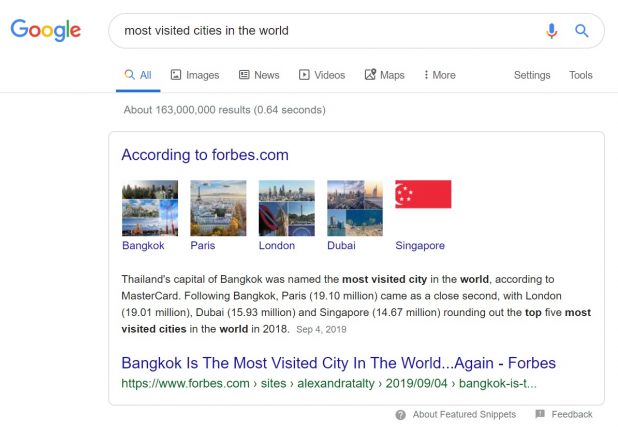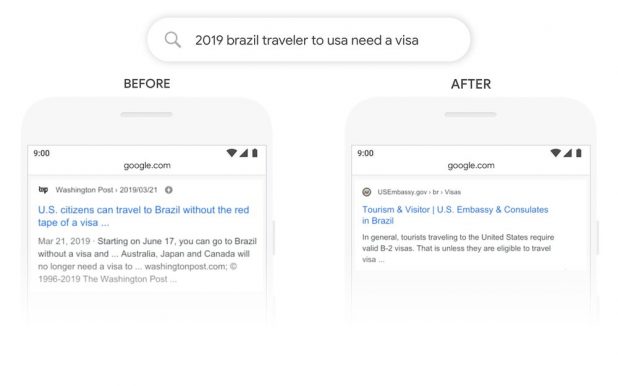Yes, it’s that time of the year again. The time when we draw the line on the year that’s almost over and make plans for the upcoming one.
If your 2020 strategy isn’t quite ready yet, keep reading. This article will shed some light on the part SEO content should play in your overall marketing strategy. Plus, you will get some tips on how to create highly effective SEO content that doesn’t break the bank.
SEO Content Trends in 2020 – What’s in and what’s out?
1. Voice search optimization
The use of voice assistance increases every day. In 2020, more people will be talking to their devices. And more devices will be talking back to them.
Couple that with the increase in mobile internet use and you’ll understand why you can’t ignore voice search in your SEO content in 2020 and beyond.
Here’s how it works:
You ask your device a question and your devices recites back at you the first organic result. Also known as a featured snippet, this is actually ‘position 0’ and it appears above the other organic results.
It looks like this:
Briefly put: when it comes to voice search, if you don’t have the featured snippet, you don’t exist. Of course, this coveted position 0 is extra-hard to obtain.
Here’s what you can do to get a shot at it:
- Ensure that your website is mobile responsive
- Use H2 and H3 headlines/questions in your content (lists are everything!)
- Provide short and to-the-point short answers to questions – no more than 90 words
More importantly, before you start writing, take a look at the featured snippet for your target keyword. What’s that website’s domain authority? Do you stand a chance of ranking higher? Can you write better content?
If you can’t answer ‘yes’ to all these questions, move on.
Ideally, all your SEO content in 2020 should be in a featured snippet-friendly format. You might get position 0 for a keyword that doesn’t even have a featured snippet yet!
2. Write for humans
I’ve been saying this for a REALLY long time: before you try to impress search engines, work on impressing your human audience. You know, the ones who may actually buy something from you.
By announcing the BERT update in October this year, Google says it too – again and loud and clear this time.
BERT stands for “Bidirectional Encoder Representations from Transformers”. It’s a “neural network-based technique for natural language processing (NLP) pre-training”.
Whoa, that was a mouthful, wasn’t it?
Before you get intimidated by these terms, you should know that they actually mean something VERY simple: Google just got better at interpreting the user intent behind every search query. Instead of interpreting every word in the query separately, the algorithm now looks at the meaning of the entire phrase.
Here’s an example Google gave:
In the ‘Before’ snapshot, the pre-BERT algorithm doesn’t take into account the preposition ‘to’. So it doesn’t understand that the query is made by a Brazilian citizen who wants to travel to the US. Consequently, it offers irrelevant results.
In the ‘After’ snapshot, with BERT already lose in the algorithm, the results are relevant for the user intent.
What does this mean for you?
First and foremost, it means that you need hyper-focused, ultra-targeted content. You need different pieces of content for all your buyer personas and for all the stages in their respective buyer journeys.
You can’t expect to catch all the flies with a single blog post.
For example, a cosmetology and dermatology clinic offering rejuvenating procedures can no longer write a single blog post for all of these procedures and hope to target everyone looking to shave a few years off their face or body. They will need to create separate content for:
- Rejuvenating procedures for men and women
- Rejuvenating procedures for various age groups (in men/women)
After this initial split comes the segmentation for every phase of the buying journey:
- Awareness – acknowledging the visible symptoms of aging
- Consideration – which procedure is best suited for each symptom (wrinkles, fine lines, sun spots and so on)
- Decision – why your clinic is the best choice for these procedures
As you can see, if you mix and match the two main criteria above, you end up with at least a dozen topics or an impressive topic cluster. Sure, some of these articles might be quite similar to each other. But this doesn’t change the fact that the reader has to be able to find themselves in your content.
Casting a wide net no longer works!
On the bright side, this means less work brainstorming new blog ideas. On the not-so-bright side, it means going back to your old content and updating it to remain relevant.
And while you’re doing that, don’t forget about the list format!
3. Long-tail keywords are your best friends
Do you know what the rise of voice search, the increase in mobile internet use and the launch of BERT spell? Long-tail keywords!
With Google getting better every day at understanding how humans talk, there’s no need for robotic-sounding search queries like ‘best coffee shop Toronto’.
You can type (or shout at your device): ‘what is the best coffee shop in Toronto’. And you will receive personalized recommendations based on your location and history.
What does this mean for you?
This is actually very good news. Long-tail keywords are (still) quite easy to rank for. And, if you choose them wisely, they have better ROI than short keywords. That’s because you can clearly target user intent in a longer keyword.
Case study time: my recently launched agency, Copywritech, managed to rank one of our clients in the top three positions in SERPS for ALL the keywords they wanted to rank for. Most of them were long-tail, ROI-producing keywords, chosen to match the entire buyer journey.
You can check out the whole case study here to get all the details about how we managed to accomplish his.
In a nutshell, long-tail keywords are excellent for both SEO and your ROI. What’s not to love?
4. Content quality matters more than anything
Google’s Quality Raters Guidelines is an already old document. But it was recently brought back to life by another Google blog post that assures us it holds true and that quality is still the most important ranking factor.
What does this mean for you?
OK, you have to publish quality content – that’s obvious. But what exactly is quality content?
First of all, it’s content that follows the E-A-T acronym:
- Expertise
- Authoritativeness
- Trustworthiness
These are three traits that prove your content is worth reading and, consequently, that’s it’s worth ranking high.
Here’s how you achieve it:
- Go long-form. Prove your expertise by going in-depth for any topic you tackle on your blog. BUT don’t write just for the sake of hitting a word count. Write just enough to cover all the aspects of an issue.
- Add a detailed bio for all the authors on your website. This hits all the three letters in E-A-T. A detailed bio shows that the author is an authority on the topic, that they have expertise in the field and, thus, that they can be trusted.
- Speaking of trustworthiness: never make claims you can’t back up. Link to relevant (high-DA) websites, research reports, authority figures, statistics that prove your claims are true. The more links to already respected publishers in your content, the more trustworthy you will be.
SEO Content Trends for 2020 – Final Thoughts
All of the above can be summed up with an urge to write for humans. Google optimizes their algorithm to be closer to how humans think, act, and search.
Why should your writing not be tailored for the same audience?
If your content is genuinely helping people, you will rank higher. So before keyword research, spend time thinking how your expertise can be of use to your audience. What could you write about that people need to know?
Keyword research, on-page SEO and back linking should come only after you are 100% convinced that you have created a piece that’s genuinely helpful and trustworthy.
Want to create content that both search engines and humans love? Check out our general copywriting and content writing services on the Idunn website or our dedicated packages for tech content writing on Copywritech, my newly-launched agency.







